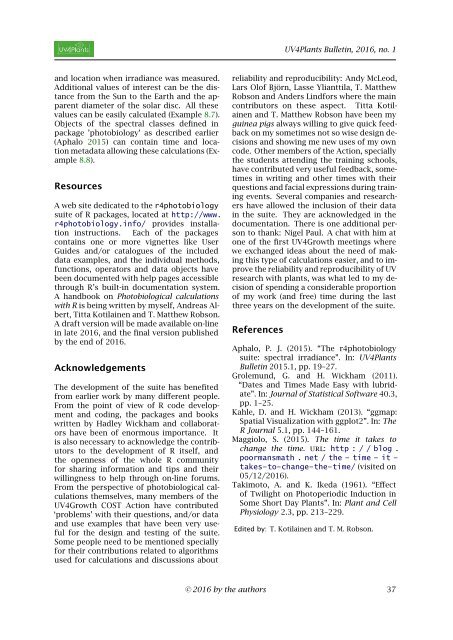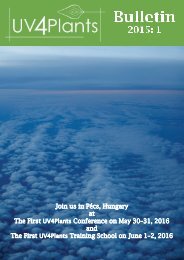UV4Plants Bulletin 2016:1
The Bulletin of the <a href="http://www.uv4plants.org>UV4Plants Association</a> is published two times per year. It is an open-access publication.
The Bulletin of the <a href="http://www.uv4plants.org>UV4Plants Association</a> is published two times per year. It is an open-access publication.
Create successful ePaper yourself
Turn your PDF publications into a flip-book with our unique Google optimized e-Paper software.
<strong>UV4Plants</strong> <strong>Bulletin</strong>, <strong>2016</strong>, no. 1<br />
and location when irradiance was measured.<br />
Additional values of interest can be the distance<br />
from the Sun to the Earth and the apparent<br />
diameter of the solar disc. All these<br />
values can be easily calculated (Example 8.7).<br />
Objects of the spectral classes defined in<br />
package ’photobiology’ as described earlier<br />
(Aphalo 2015) can contain time and location<br />
metadata allowing these calculations (Example<br />
8.8).<br />
Resources<br />
A web site dedicated to the r4photobiology<br />
suite of R packages, located at http://www.<br />
r4photobiology.info/ provides installation<br />
instructions. Each of the packages<br />
contains one or more vignettes like User<br />
Guides and/or catalogues of the included<br />
data examples, and the individual methods,<br />
functions, operators and data objects have<br />
been documented with help pages accessible<br />
through R’s built-in documentation system.<br />
A handbook on Photobiological calculations<br />
with R is being written by myself, Andreas Albert,<br />
Titta Kotilainen and T. Matthew Robson.<br />
A draft version will be made available on-line<br />
in late <strong>2016</strong>, and the final version published<br />
by the end of <strong>2016</strong>.<br />
Acknowledgements<br />
The development of the suite has benefited<br />
from earlier work by many different people.<br />
From the point of view of R code development<br />
and coding, the packages and books<br />
written by Hadley Wickham and collaborators<br />
have been of enormous importance. It<br />
is also necessary to acknowledge the contributors<br />
to the development of R itself, and<br />
the openness of the whole R community<br />
for sharing information and tips and their<br />
willingness to help through on-line forums.<br />
From the perspective of photobiological calculations<br />
themselves, many members of the<br />
UV4Growth COST Action have contributed<br />
‘problems’ with their questions, and/or data<br />
and use examples that have been very useful<br />
for the design and testing of the suite.<br />
Some people need to be mentioned specially<br />
for their contributions related to algorithms<br />
used for calculations and discussions about<br />
reliability and reproducibility: Andy McLeod,<br />
Lars Olof Björn, Lasse Ylianttila, T. Matthew<br />
Robson and Anders Lindfors where the main<br />
contributors on these aspect. Titta Kotilainen<br />
and T. Matthew Robson have been my<br />
guinea pigs always willing to give quick feedback<br />
on my sometimes not so wise design decisions<br />
and showing me new uses of my own<br />
code. Other members of the Action, specially<br />
the students attending the training schools,<br />
have contributed very useful feedback, sometimes<br />
in writing and other times with their<br />
questions and facial expressions during training<br />
events. Several companies and researchers<br />
have allowed the inclusion of their data<br />
in the suite. They are acknowledged in the<br />
documentation. There is one additional person<br />
to thank: Nigel Paul. A chat with him at<br />
one of the first UV4Growth meetings where<br />
we exchanged ideas about the need of making<br />
this type of calculations easier, and to improve<br />
the reliability and reproducibility of UV<br />
research with plants, was what led to my decision<br />
of spending a considerable proportion<br />
of my work (and free) time during the last<br />
three years on the development of the suite.<br />
References<br />
Aphalo, P. J. (2015). “The r4photobiology<br />
suite: spectral irradiance”. In: <strong>UV4Plants</strong><br />
<strong>Bulletin</strong> 2015.1, pp. 19–27.<br />
Grolemund, G. and H. Wickham (2011).<br />
“Dates and Times Made Easy with lubridate”.<br />
In: Journal of Statistical Software 40.3,<br />
pp. 1–25.<br />
Kahle, D. and H. Wickham (2013). “ggmap:<br />
Spatial Visualization with ggplot2”. In: The<br />
R Journal 5.1, pp. 144–161.<br />
Maggiolo, S. (2015). The time it takes to<br />
change the time. url: http : / / blog .<br />
poormansmath . net / the - time - it -<br />
takes-to-change-the-time/ (visited on<br />
05/12/<strong>2016</strong>).<br />
Takimoto, A. and K. Ikeda (1961). “Effect<br />
of Twilight on Photoperiodic Induction in<br />
Some Short Day Plants”. In: Plant and Cell<br />
Physiology 2.3, pp. 213–229.<br />
Edited by: T. Kotilainen and T. M. Robson.<br />
© <strong>2016</strong> by the authors 37



